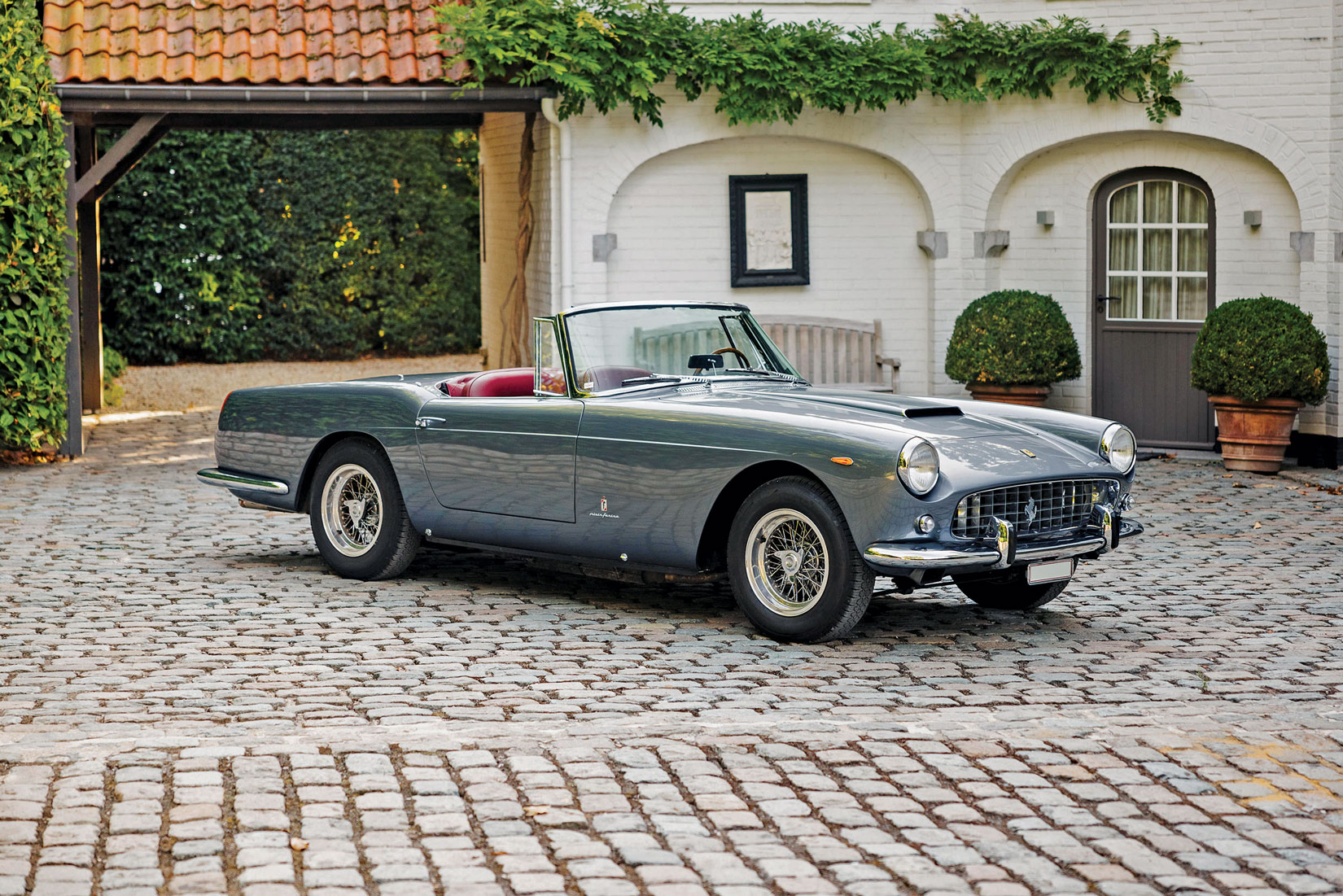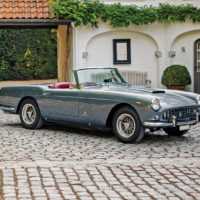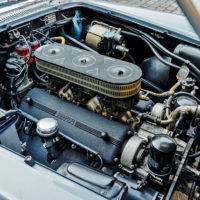By the early 1960s, road-car production had ceased to be a sideline for Ferrari and was seen as vitally important to the company’s future stability. Thus the 250, Ferrari’s first volume-produced model, can be seen as critically important. True series production began with the Pinin Farina “notchback” coupe on the 250 GT chassis.
A number of coachbuilders offered a variety of body styles on the 250 GT chassis. Mario Boano’s cabriolet on chassis number 0461GT, exhibited at Geneva in March 1956, is considered the probable inspiration for the Pinin Farina-designed cabriolet series that followed. Around 40 Series I Pinin Farina-styled examples were completed before the introduction of the Series II in 1959. The Series II cars benefited from the latest 240-hp Tipo 128F V12 engine with outside spark plugs, coil valve springs and 12-port cylinder heads. The 250 GT was the most successful Ferrari of its time, production of all types exceeding 900 units, of which 200 were Series II Cabriolets.
Between 2007 and 2008, this car was fully restored to the highest standards by recognized specialists Carrozzeria Cremonini in Modena, Italy. Invoices on file for the period 2011 to 2020 total over €50,000, mainly for regular maintenance including a new clutch and five new tires in 2019.
SCM Analysis
Detailing
| Vehicle: | 1961 Ferrari 250 GT PF Cabriolet Series II |
| Years Produced: | 1959–62 |
| Number Produced: | 203 |
| SCM Valuation: | $1,259,000–$1,749,000 |
| Tune Up Cost: | $3,000 |
| Chassis Number Location: | Left frame member below the steering box |
| Engine Number Location: | Right rear above the motor mount |
| Club Info: | Ferrari Club of America |
| Website: | http://www.ferrariclubofamerica.org |
| Alternatives: | 1964–66 Lamborghini 350 GT, 1958–63 Aston Martin DB4 drophead coupe, 1959–64 Maserati 3500 GT Vignale Spyder |
| Investment Grade: | B |
This car, Lot 120, sold for $1,070,322 (€1,092,500), including buyer’s premium, at Bonhams’ Knokke, Belgium, sale on October 9, 2022.
In 1959, American cars were anything but conservative. Cadillacs once sported the highest fins of their era, only to be one-upped by Chrysler’s Imperial, which featured even larger fins. Over at Ford, the Lincoln Continental’s restraint with its rear appendages was canceled by its weirdly angled headlights. Excess defined the styling of the times, but across the pond, Pinin Farina missed the memo.
Enzo’s cab arrives
The Pinin Farina-styled Ferraris of the era (Pinin Farina was not renamed “Pininfarina” until 1961) kept to the beautiful compound curves that had made it Enzo Ferrari’s styling house of choice.
Ferrari’s 1959 debutante was the 250 GT Pinin Farina Cabriolet Series II. The Cabriolet was the open-top sister to the 250 GT Pinin Farina coupe, Ferrari’s best seller up to that time, however a cabriolet version was sure to add a significant donation to the till. While considered high-volume production models, just 353 250 GT PF coupes were built during its 1958–60 production run. Just 202 250 GT PF cabriolets were built from 1959 to ’62. When contrasted against Ferrari’s current production of around 200 cars every week, calling the 250s high-volume models is almost laughable.
The Series II PF Cabriolet followed an earlier “Series I” PF Cabriolet built between 1957–59. Just 40 examples of the Series I cabriolets were built, and they are among Ferrari’s most coveted cars, with values exceeding $5m. The Series 1 Cabriolet was a lovely car with covered headlights, front bumperettes and a raked windshield. The taillights were frenched into the rear fenders and the door handles were flush with the body.
Unfortunately, the Series II Cabriolet lost many of the early car’s best features. The covered headlights were replaced with open headlights, and the taillights were attached to the body rather the being integral to the design. The windshield was more upright to make the car more comfortable for a tall driver. The flush door handles were replaced with common bolt-on versions and even the bucket seats of the Series I were replaced with seats that resembled a split bench.
Two by two
There were two distinct groups of Series II 250 Cabriolets, each with roughly 100 examples. The first group started with serial number 1537 and ended with serial number 2157. The second group picked up at number 2211 and ended at 3807. At this time, Ferrari only used odd serial numbers for production cars and interspersed different models in the serial-number range. The different Series II groups corresponded to two different chassis types. The first group used a Type 508 E chassis with a coil-spring front suspension with semi-elliptical leaf springs and Houdaille lever shocks in the rear. The latter group used a Type 508 F chassis, which also featured coil springs up front, but the rear shocks were updated to a modern tubular style.
There were numerous other differences including differences in the dash and cloth top, but the chassis difference is what makes the second Series II cars more desirable to some collectors. Bonhams’ auction of 2319GT was one of several Series II Cabriolet sales this year. At $1,070,322, it was the lowest price of the bunch in 2022, among the cheapest PF cabs of the past decade. For a Classiche-certified example that has been restored by a well-known shop and comes with a factory hard top, that’s a bit puzzling.
Advantage: buyer
As delivered, 2319GT was Pinin Farina body number 29905, finished in Grigio Scuro with a black leather and vinyl interior. It was one of nine cars finished in this attractive dark gray color. In 1973, 2319GT was advertised as having been overhauled with new upholstery and paint. In 1990, an ad described it as being “all complete,” not a sparkling endorsement for a car you’re selling. Later in 1990, it was reported as being dark green and needing restoration. By 1996 2319GT was offered for sale, described as an “older restoration,” code for restoration being needed again. Apparently, later in the ’90s, a restoration was done, as the car was then reported to have been repainted black. The car was then re-restored by a well-regarded Italian specialist in its current color in 2007–08.
SCM’s 2023 Pocket Price Guide puts the 250 GT PF Cabriolet Series II in the $1,259,000–$1,749,000 range. Another Series II Cab sold in the $1.1 million range this year, so this sale was low but not out of line. Sometimes it’s hard to erase a hard life, and that may be the case with 2319GT. Spots of surface rust evident in the engine pictures indicate that despite a reported $50,000 having been spent on the car in the past 11 years, it wasn’t enough.
The buyer got in at a great price if the car checks out. It’s easy to drop big bucks making minor improvements to a car, and I think this one will need some. On the other hand, this softening of the market for non-A-list V12 Ferraris likely disappointed the seller. Call this one in favor of the buyer. ♦
(Introductory description courtesy of Bonhams.)




